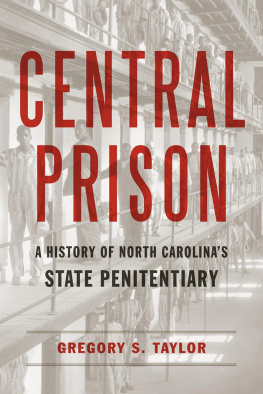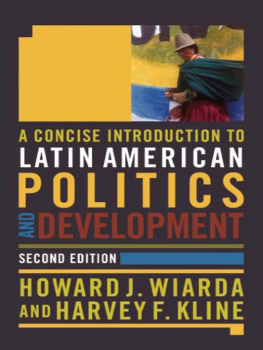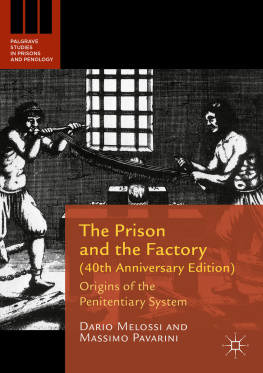
New Interpretations of Latin America Series
The Birth of the Penitentiary in Latin America:
Essays on Criminology, Prison Reform, and Social Control, 1830-1940
Edited by
Ricardo D. Salvatore
and
Carlos Aguirre

University of Texas Press, Austin Institute of Latin American Studies
Copyright 1996 by the University of Texas Press
All rights reserved
Printed in the United States of America
First Edition, 1996
Requests for permission to reproduce material from this work should be sent to Permissions, University of Texas Press, P.O. Box 7819, Austin, Texas 78713-7819
utpress.utexas.edu/index.php/rp-form
Library of Congress Cataloging-in-Publication Data
Library ebook ISBN: 978-0-292-76347-0
Individual ebook ISBN: 978-0-292-78763-6
DOI: 10.7560/777064
The birth of the penitentiary in Latin America : essays on criminology, prison reform, and social control, 1830-1940 / edited by Ricardo D. Salvatore and Carlos Aguirre.
p. cm. (New Interpretations of Latin America Series)
Includes bibliographical references (p. ) and index.
ISBN 0-292-77707-8 (pbk. : alk. paper)
1. PrisonsLatin AmericaHistory I. Salvatore, Ricardo Donato.
II. Aguirre, Carlos. III. Series.
HV9510.5.B57 1996
365.98dc20
96-3851
CIP
En realidad se trata de una usina, de un gigantesco laboratorio, en el cual la materia prima con que se trabaja e investiga no es ni el metal, ni la lana, ni el algodn, sino que otra mucho ms noble, y de ms difcil manipulacin, como es la materia humana viciada o degenerada, desgraciada o sufrida. Ah se transforma a los carcomidos por el vicio y el crimen, en seres tiles a la sociedad
[It is actually a factory, a gigantic laboratory, in which the raw material they work with and investigate is not metal, wool, or cotton, but one much more noble and of much more difficult manipulation: humans, corrupted or degenerated, unfortunate or long-suffering. There, those ruined by vice and crime are transformed into human beings useful to society.]
Israel Drapkin, Actualidades penales y penitenciarias del Brasil
(Santiago, 1939)
Contents
In 1834, Brazilian authorities began the construction of the Casa de Correo in Rio de Janeiro, the first institution of confinement in Latin America to be built following the penitentiary principles. During the next one hundred years or so, within different time frames and with varied degrees of commitment and success, most Latin American countries adopted the penitentiary project; that is, they decided to build penitentiaries and reformatories and, more generally, embarked on successive attempts at prison reform. The general aimas it was presented in the rhetoric of authorities and reformerswas to eradicate the ruinous, unhealthful, inefficient, and inhumane jails that existed all over the region and to replace them with modern, scientific, and rehabilitative institutions for transforming the criminal into an obedient, hard-working, law-abiding subject. Reformers embraced the new criminological science (heavily influenced by positivism), placed anthropometric research facilities in their carceral institutions, enhanced the power of experts (criminologists, physicians, teachers) within the prison, generated the statistics needed to analyze the problems of crime, and gradually induced changes in their penal legislation in order to incorporate the most recent European and North American innovations in the science of punishment. By doing so, Latin American elites and public authorities sought to offer civilized, scientific, and effective solutions to the criminal question
As with so many imported cultural, political, social, and technological devices, the adaptation of Western penal institutions in Latin America was controversial and complex. With so many factors impinging upon the process, the ultimate outcome of this adaptation was bound to diverge from the original design, despite all the hope and energy invested by the reformers. A number of factors hindered the progress of penitentiary reform: scarce state revenues, unsuitable legislation, prevailing patterns of social control, and the hegemony of discourses that justified traditional ways of interaction between classes, sexes, and races. In spite of poor results, the penitentiary ideal was never really challenged, and it remained throughout this period as the prima donna of the whole process of penal reform. It epitomized all the dreams and obsessions of Latin American state officials, local authorities, scientists, lawyers, and of course ruling elites. It established itself as both the solution to their concerns about crime and social disorder and the ultimate symbol of modernity and civilization. While the basic penitentiary principles were shared by each countrys respective reformers, each case required different adjustments due to specific local conditions and to concrete political and ideological configurations.
This volume attempts to shed new light on the protracted, multifaceted, and ambiguous process of modernization in Latin America by analyzing the fate of prison reform and its connections with broader social issues. By analyzing the multiple factors influencing the building, operation, and reform of carceral institutions in Latin America, the essays in this collection try to address a topic rarely explored in the historiography of modern Latin America. The long century that elapsed between the beginning of the construction of the Casa de Correo in Rio de Janeiro (1834) and the year in which Cuba finally adopted the penitentiary system (1939) is the time period chosen for this study, a period that, as any student of the modem history of Latin America knows, witnessed dramatic changes in the social structure, economic development, political forms, and ideological trends of Latin American countries.
This book grew from an initial encounter between the editors in Minneapolis, Minnesota, in November 1990. Plans for an AHA panel first and then an edited collection of essays developed after we realized that some of our common research interests had been inadequately dealt with in the existing literature. We were struck by the fact that in spite of all the symbolic and political importance of prisons in modern Latin American history and the rather dramatic situation of the regions prisons during the 1980s (several major prison riots broke out in some of the most important Latin American cities), the attention the subject had received from the scholarly community was rather limited. Consequently, we set out to organize a collection of papers that could stimulate discussion about the history of prisons, penitentiaries, and reformatories in the context of changing social structures and ethnic, class, and gender identities and relationships, as well as shifting discourses about society.
While Foucaults elaborations on the history of the prison, his arguments about the connections between modernity and panopticism, and his broader theoretical and methodological assumptions have all been subjected to various forms of criticism, there is no doubt that Surveiller et punir is still a source of inspiration for a whole range of studies on institutions of incarceration all over the world.
Although this collection of essays was not conceived as a test of Foucaults thesis for Latin America, the cases we study here will furnish new and interesting materials that should enrich the debates about these issues. In Latin America there has been scant interest in the history of prisons until very recently, a neglect that is indeed unfortunate. This situation arises in part due to the fact that many Latin American historians, trapped in the net of old concepts and theories, see the prison as just one more institution of the state, probably the least remarkable and appealing. Unable to draw the connection between the prison and the objects of study of more fashionable areas of social, intellectual, and political history (the state, labor, ideologies, political parties, social conflict, women, the family), historians do not consider the study of prisons to be crucial for the understanding of our past. The recent explosion of studies on hidden and obscure spaces, subordinate social groups, day-to-day forms of social control, the construction of hegemony, and subaltern resistance makes us view with optimism the prospect of increasingly sophisticated scholarship on the history of prisons, reformatories, and other similar institutions in Latin America.








 New Interpretations of Latin America Series
New Interpretations of Latin America Series University of Texas Press, Austin Institute of Latin American Studies
University of Texas Press, Austin Institute of Latin American Studies